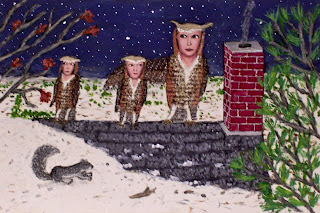 Flower Portrait - Rembrandt Tulips 16 x 12, Acrylic
Flower Portrait - Rembrandt Tulips 16 x 12, AcrylicRembrandt Tulips 18 x 14, Acrylic
Windmill on the Shore 12 x 16, Acrylic, 2003.
Rembrandt Tulip Fairy, 10 x 8, Acrylic, 2011.
 Flowers have been an obvious subject for painters and no doubt remain so
for those who are drawn to traditional subject matter. Not immune to
the allure of the floral, I have tried my hand at it, mostly with
stylized compositions of multiple flowers. However, I have done a few
simple flower pictures, the best being Flower Portrait - Rembrandt Tulips. and again with a less conventional composition in Rembrandt Tulips.
I figured these represented my best efforts and as the response to them
was underwhelming at best, I never pursued the genre. However, I have
managed to work flowers, particularly tulips, into various pictures,
among them the scenic Windmill by the Sea (which is consigned to Grey Arts) and, more recently, the Rembrandt Tulip Fairy.
--- Tulips, by the way, weren't introduced to Europe until the 16th
Century. They were highly prized and in the 1630's, there was the
famous Tulip Craze in which bulbs, traded as a commodity, commanded
absurdly high prizes -- until the bubble finally burst. The most
admired tulips were those with variegated colors, caused, we now know,
by a virus. The were called Rembrandt tulips after the master artist
who never painted them, (but who was, after all, Dutch). The originals
are no longer grown, but recently varieties have been bred to be
Rembrandt look-a-likes. I am very much drawn to them, although I must
confess I do not recall actually ever seeing one! This is not surprising, since I
feel inspired to paint things I have never seen.
Flowers have been an obvious subject for painters and no doubt remain so
for those who are drawn to traditional subject matter. Not immune to
the allure of the floral, I have tried my hand at it, mostly with
stylized compositions of multiple flowers. However, I have done a few
simple flower pictures, the best being Flower Portrait - Rembrandt Tulips. and again with a less conventional composition in Rembrandt Tulips.
I figured these represented my best efforts and as the response to them
was underwhelming at best, I never pursued the genre. However, I have
managed to work flowers, particularly tulips, into various pictures,
among them the scenic Windmill by the Sea (which is consigned to Grey Arts) and, more recently, the Rembrandt Tulip Fairy.
--- Tulips, by the way, weren't introduced to Europe until the 16th
Century. They were highly prized and in the 1630's, there was the
famous Tulip Craze in which bulbs, traded as a commodity, commanded
absurdly high prizes -- until the bubble finally burst. The most
admired tulips were those with variegated colors, caused, we now know,
by a virus. The were called Rembrandt tulips after the master artist
who never painted them, (but who was, after all, Dutch). The originals
are no longer grown, but recently varieties have been bred to be
Rembrandt look-a-likes. I am very much drawn to them, although I must
confess I do not recall actually ever seeing one! This is not surprising, since I
feel inspired to paint things I have never seen.






